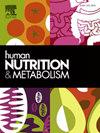Sex-specific association of blood triglyceride and uric acid with body shapes in Chinese adults
IF 1.8
Q3 ENDOCRINOLOGY & METABOLISM
引用次数: 0
Abstract
Background
Abnormal metabolic syndrome, adipose distribution and different body shapes caused by obesity are associated with the levels of blood biochemical indexes. However, the sex-specific relationship between body shapes and blood biochemical indexes is poorly investigated.
Research design and methods
A cross-sectional study was conducted on 1828 subjects matched by age and sex. The scatter plot and restricted cubic spline were used to analyze the correlation between variables. Logistic regression was used to explore the relationship between body shapes and the risk of abnormal blood biochemical indexes level.
Results
Compared with the non-obesity group, the compound obesity group had a higher risk of abnormal Glu and TG levels independent of sex. Besides, the sex-specific association showed that the risk of abnormal TG levels was higher in males with peripheral obesity but in females with central obesity. Meanwhile, female subjects with peripheral obesity had a higher risk of abnormal UA levels.
Conclusions
This study showed that obese subjects had a higher risk of abnormal UA and TG compared to non-obese subjects, and there were sex differences in this relationship, suggesting that future studies exploring the relationship between body shapes and blood biochemical indexes also need to consider the potential role of sex.
中国成人血甘油三酯和尿酸与体型的性别特异性关联
背景肥胖引起的代谢异常综合征、脂肪分布及不同体型与血液生化指标水平相关。然而,体型和血液生化指标之间的性别特异性关系研究甚少。研究设计与方法对1828名年龄、性别相匹配的受试者进行了横断面研究。采用散点图和受限三次样条分析变量间的相关性。采用Logistic回归方法探讨体型与血液生化指标异常风险水平的关系。结果与非肥胖组相比,复合肥胖组与性别无关的Glu和TG水平异常的风险更高。此外,性别特异性关联表明,外周性肥胖的男性TG水平异常的风险高于中心性肥胖的女性。同时,女性外周性肥胖受试者UA水平异常的风险更高。结论本研究显示肥胖受试者UA和TG异常的风险高于非肥胖受试者,且这种关系存在性别差异,提示未来探讨体型与血液生化指标之间关系的研究还需要考虑性别的潜在作用。
本文章由计算机程序翻译,如有差异,请以英文原文为准。
求助全文
约1分钟内获得全文
求助全文
来源期刊

Human Nutrition and Metabolism
Agricultural and Biological Sciences-Food Science
CiteScore
1.50
自引率
0.00%
发文量
30
审稿时长
188 days
 求助内容:
求助内容: 应助结果提醒方式:
应助结果提醒方式:


